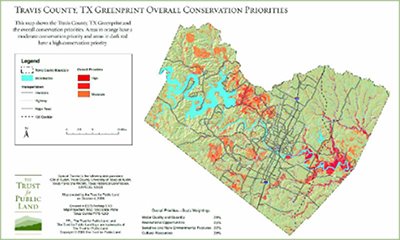Central Texas Greenprint for Growth: A Tool for Balancing Sustainable Conservation Goals with the Infrastructure Needs of Our Rapidly Urbanizing Region

Travis County Conservation Priority Plan. (Courtesy of
CAPCOG)
Capital Area Council of Governments
| Total cost: |
$227,764 |
| FHWA share: |
$113,882 |
| Period of performance: |
24 months |
| Dates: |
May 16, 2008 – May 16, 2010 |
| Status: |
Complete |
| AOTR: |
Michael Lamprecht |
| Grant-project website: |
https://www.capcog.org/ |
Project Goals
The goal of the Capital Area Council of Governments (CAPCOG) Eco-Logical grant project was to create a Greenprint for the Central Texas region to help planners and transportation agencies plan for future growth. With input from regional and local stakeholder groups, CAPCOG’s Greenprint for Growth plan prioritized the protection of water quality, ecological resources, farm and ranch lands, recreational and cultural resources, and scenic corridors. The Greenprint expanded on a previous CAPCOG project, the Travis County Greenprint, to include three other counties in the Austin-Round Rock metropolitan statistical area. (Williamson County did not participate.)
Project Accomplishments
CAPCOG completed the final report, maps, and opportunity areas for the three additional counties in 2010. The Greenprint for Growth integrated data into a GIS model that prioritized conservation opportunities and displayed them in a series of maps, available in print and on the Greenprint website. During development of the maps, CAPCOG held a series of meetings with elected officials, technical experts, and county representatives to determine the county and regional priorities that informed the maps and the individual county-based Greenprint reports. The priorities from the Greenprint for Growth were included in the Bastrop County Comprehensive Transportation Plan and informed the selection of conservation easements and mitigation lands in Travis and Hays Counties. CAPCOG’s work encouraged the counties to consider environmental effects earlier in the transportation planning process. The project compiled data and identified environmentally sensitive areas within land parcels to evaluate impacts on a closer scale.
Future Steps
CAPCOG continues to promote use of the Greenprint among local governments, although some counties and cities have withdrawn support due to changing regional politics. CAPCOG is supporting the 2014 update of the Capital Area Metropolitan Planning Organization’s 2040 long-range transportation plan and is working to incorporate Greenprint data into this update. CAPCOG’s Greenprint data and investments have also helped to inform and support the ongoing Pecan Street Project Inc. effort, which explores the use of renewable energy in the Austin area and earned the 2012 Innovation Award from the National Association of Development Organizations.
Insights on Eco-Logical
By using the Eco-Logical approach, CAPCOG was able to work with many entities, including non-profits, county governments, and municipalities, and establish stronger partnerships than had existed prior to the development of the Greenprint. However, over time, CAPCOG has faced challenges in continuing the implementation of its Eco-Logical grant project, in large part due to the lack of an implementing agency from project inception. It has been difficult for CAPCOG to encourage buy-in from local decisionmakers and stakeholders. As a result of its involvement in the Eco-Logical grant program, CAPCOG recognizes the importance of involving stakeholders, including environmental and transportation agencies, at the start of a project and developing tailored communication methods for specific audiences.
<< Return to Grant Projects

